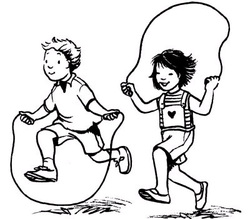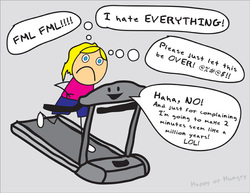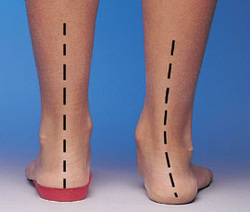
I've been jumping rope a lot more lately as part of crossfit-type exercises I've been doing. I used to do it quite a bit in college as part of a similar exercise routine; when I was a junior, I took a marine ecology research class on Appledore island off the NH-ME border. On that wonderful island, I did two forms of exercise. First, I would jump rope in a gazebo with panoramic Atlantic ocean views. Then, avoiding aggressive nesting seaguls, I trail ran with two girls from the Cornell University XC team. (Those seemingly kind, nerdy science girls unleashed a pace of abuse for that entire summer) What I started to realize, in rare states of lucidity on those lung-searing runs, was that I felt "springier" that summer. It was part of a transition that I began at that time: get off the road and onto the trails. This helped change my gait to a shorter-stride, land-beneath-your center-of-gravity, midfoot strike. This was done completely unconsciously; the trails forced me to make this transition. What I didn't quite realize then was that the jumprope was making this transition easier.
As many minimal/barefoot converts know, achilles and calf pain/strain is the top complaint when making a gait switch from heel to mid or forefoot. Landing here turns your achilles into an effective spring, aiding in forward momentum, but if you've never used this complex of muscle and tendon in this manner, it can suffer overuse quickly.
This is where the jumprope comes in. Jumping rope is like running with a mid or forefoot strike, but not actually going forward. It helps train that gastrocnemius/soleus/achilles tendon into an effective spring. That springy feeling on a run doesn't come unless you're using this group of muscles/tendon properly.
So, in addition to eccentric calf exercises, one legged stands and squats, and the other prepatory exercises mentioned before, jumping rope is ideal to help you in that transition of heel to midfoot (or forefoot) striking. Add in double unders, one-legged skips, shuffle skips to add some variety, and have fun!!
As many minimal/barefoot converts know, achilles and calf pain/strain is the top complaint when making a gait switch from heel to mid or forefoot. Landing here turns your achilles into an effective spring, aiding in forward momentum, but if you've never used this complex of muscle and tendon in this manner, it can suffer overuse quickly.
This is where the jumprope comes in. Jumping rope is like running with a mid or forefoot strike, but not actually going forward. It helps train that gastrocnemius/soleus/achilles tendon into an effective spring. That springy feeling on a run doesn't come unless you're using this group of muscles/tendon properly.
So, in addition to eccentric calf exercises, one legged stands and squats, and the other prepatory exercises mentioned before, jumping rope is ideal to help you in that transition of heel to midfoot (or forefoot) striking. Add in double unders, one-legged skips, shuffle skips to add some variety, and have fun!!


 RSS Feed
RSS Feed